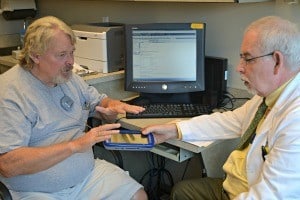Deep Brain Stimulation Helps Cabot Man
| In the neurology clinic at the Jackson T. Stephens Spine and Neurosciences Institute of the UAMS, Dr. W. Steven Metzer performed the initial programming of Tommy Rickman’s deep brain stimulator.
“There are four little electrodes down in your brain,” explained Dr. Metzer, a neurologist. “I’m trying to find the best one,” he said.
He plugged in data to a hand-held device that adjusts the frequency stimulus from a generator embedded beneath the skin, just below the collarbone, that’s connected by a thin, insulated wire to the electrodes in Tommy Rickman’s brain.
“I’ll turn the generator up a little bit. If you see any flashing lights, just let me know.”
“You mean in my eyes? I see those all the time!” exclaimed Tommy, 61, of Cabot.
Dr. Metzer refined his question: “Do you see any new flashes?” he asked, laughing.

Dr. W. Steven Metzer (right) performs the initial programming of Tommy Rickman’s deep brain stimulator.
This is the kind of patient-doctor consultation that Dr. Metzer conducts four or five times a week for patients who have essential tremor, like Tommy, or other neurologic disorders such as Parkinson’s or dystonia.
Essential tremor is a benign, sometimes inherited condition that makes simple tasks like using a pen, holding a glass without spilling its contents or shaving difficult and, if symptoms worsen, impossible. Tremor can involve the hands, head, voice and legs.
“I’ve never been able to do this since I can’t say when,” Tommy said, as his voice trailed off as though speaking only to himself, about touching index finger to thumb on his right hand.
Dr. Metzer asked Tommy to go through a battery of exercises such as reciting nursery rhymes, drawing spirals on a sheet of paper and holding each hand straight out, and he looked for any signs of rhythmic shaking and checked in with Tommy:
“Any tingling?”
“How does that feel?”
“The left hand is better, but the right hand is quite cool,” said Tommy.
“Then let me see if I can change the circuit and give you a little more juice for your left hand,” Dr. Metzer said.
The consult is not without a little programmer humor.
“Now stick out your tongue, touch your ear.”
In this adjustment, post-surgery phase, Tommy’s brain will, as Dr. Metzer said, “get used to” the charge. Dr. Metzer said he enjoys “programming people because it really helps a lot.”
“You don’t have any side effects,” from the surgery, Dr. Metzer informed Tommy. “She’s really got good electrode placement here,” Dr. Metzer said, referring to Dr. Erika Petersen, Arkansas’ only fellowship-trained functional neurosurgeon.
When medications were no longer controlling his tremor, Tommy was referred to Dr. Petersen.
“Well, I’ve been hiding this problem for years because I could,” said Tommy, then he corrects himself. “People noticed me shaking; I just thought I was hiding it. The bobblehead issue geared me toward Dr. Petersen to begin with.”
To evaluate candidates for deep brain stimulation surgery, Dr. Petersen worked with a collaborative, multidisciplinary team that includes Dr. Metzer as well as Dr. Sami I. Harik and Dr. Jennifer Kleiner-Fausett, a neuropsychologist.
They hold monthly conferences to review the specifics of each case, including the position of electrodes, and whether the surgery would likely improve a patient’s quality of life.
“The message for patients to hear,” said Dr. Petersen, “is that there are surgical treatments for patients whose medications are not helping enough.” Deep brain stimulation is reversible and does not permanently disrupt the brain because it creates an electric force field of sorts in an area of the brain responsible for essential tremor. In the early 1980s, Petersen said, a big push to understand motor controls deep within the basal ganglia helped doctors understand motor disorders better.
With the help of precise planning and MRI scans, Dr. Petersen is able to target within a millimeter of accuracy exactly where she wants to place the electrodes in a patient’s brain. A patient is given numbing medication and is awake during the entire process so Dr. Petersen and her team can register any initial side effects, such as cramping or difficulty with speech, and document the decrease in shaking and other symptoms. A halo-style metal frame is used to secure the patient’s head during the procedure.
Part two of the deep brain procedure takes place about a week later when a small generator that serves as a battery pack is placed beneath the skin, just below the collarbone.
“Surgery is the easiest part,” Tommy said. “The surgery is not as bad as one might think it is. I would recommend it to people to go ahead and give it some more consideration than just a parting shot. I think that the surgery does work. I’m pretty amazed myself with what they did.”
Now, after instruction from Dr. Metzer, Tommy and his wife, Lena, know how to operate the device that turns off the deep brain stimulator when he goes to bed.
“Cool,” Lena said. “I can handle it.”
